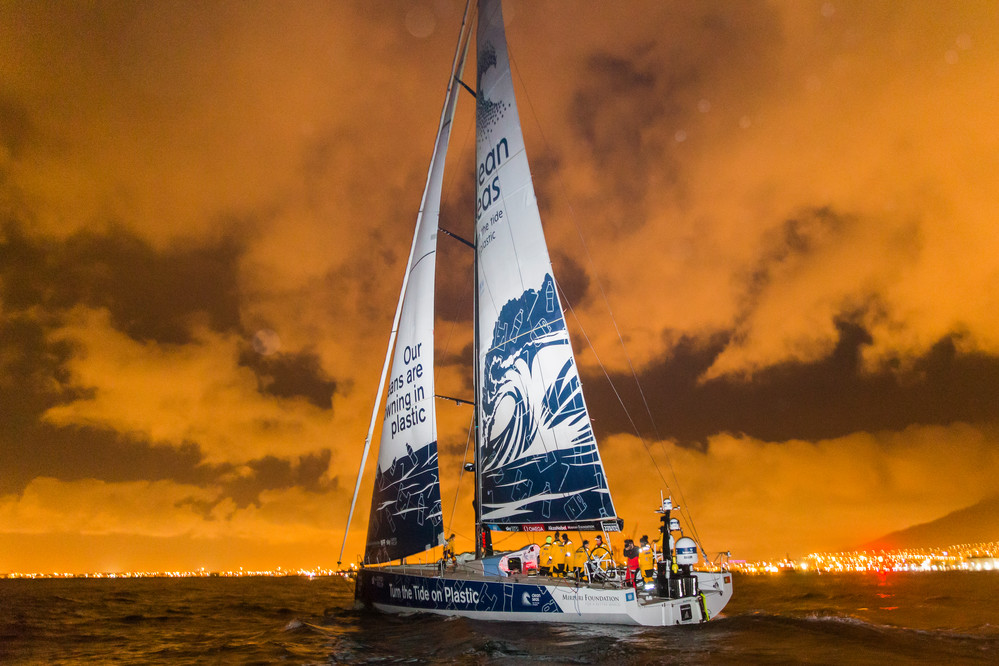
We arrived into Cape Town on Saturday night in last place and my team and I were heartbroken. After 21 days at sea, 7000 miles of intensive and close racing and with fifth place within our grasp right up until the very end, the final result was decided by just 1minute and 8 seconds. We have had one hell of an Ocean Match Race on this leg.
The exit from Lisbon was a baptism of fire and we experienced 30 knots before we even left the river. The wind peaked at 35 knots and the conditions remained like this for the first couple of days. Sending it fast resulted in walls of water cascading down the deck and crew members being washed off their feet. With experience being everything in these conditions, we lacked the quality of drivers and it was a tense few days as the less experienced crew members adapted. We changed gear from a fractional sail and a reef to a full main and a mast head sail and started to sail faster and lower, matching the rivals we had lost some ground to.
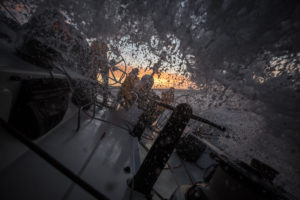
We gybed our way south and west on the trade winds as they shifted, sailing west of all the Atlantic island chains – Madeira, Canary Islands and Cape Verde. Next up were the doldrums – or were they? It was the oddest doldrum crossing as we didn’t really stop and we didn’t really slow down. We had some funky cloud action and intense rain showers with thunder and lightning but we managed to avoid the days of being becalmed that can so easily happen. I would hazard a guess that it was probably one of the fastest crossings of the doldrums yet and by 5 degrees north we were free and sailing up wind on the south east trades.
Next stop was the equator and I had six pollywogs (as they are affectionately known) that needed initiating. Those yet to cross the equator need blessing by King Neptune, they must be punished for any crimes and need to show they are worthy. Only then they will get safe passage. So, the choice for my guys was to either humiliate themselves on camera with a hidden skill unknown to us, take on the flying fish by biting their heads off or take a trip to the hairdresser. Frederico entertained Neptune (and us) with some traditional Portuguese dancing, Annalise and Bianca decided to get in training for I’m a Celebrity and went for the fish head biting option and Lucas and Henry are now sporting spectacular reverse mowhawks, with Francesca losing her ponytail. King Neptune was obviously pleased with the array of talent and dedication and we safely crossed the equator.
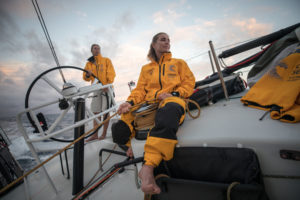
The south east trade winds provided a long blast of a reach on port tack going south. We were running along the edge of the Brazilian coastline trying to go around the outside of the St Helena high pressure. We were lifted early and were at risk of going into lighter winds so we gybed to get more south and stay in more pressure. This gybe felt counter intuitive as it had us sailing away from Cape Town – in fact we were closer to Cape Horn than we were to Cape Town. We did a few gybes to try and get into a better position all the while with an eye on the others that were further south and therefore always had a commanding position.
The match race really started form this point onwards and from the southern hemisphere we were either in sight physically or on AIS (electronic positioning signal on our navigation software) of Scallywag for every single day of the race. It was incredible, even when we split gybes and went in separate directions we still came back together again with several port starboard incidents.
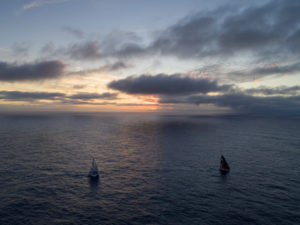
Although the conditions initially were demanding for the crew not used to offshore sailing, generally the race and weather were comparatively easy this leg. There were not so many sail changes and manoeuvres, however, the intensity of having another boat within a couple of miles all the time really did ramp up the pressure and was an incredible focus.
We headed south and then came east along the bottom of the Atlantic riding a cold front that we stayed with for some time. At this point the whole fleet were within 80 miles of each other and this was really exciting.
At this point, the north of the fleet slowed down a little and AzkoNobel and Scally’s joined us as the weather ahead changed. A big blocking high pressure stood between the three of us and Cape Town and we had two options. Should we try and wiggle through to the north or head south and go round the bottom, sailing more miles but in faster conditions. Psychologically this was difficult as we would be sailing at 90 degrees from where we wanted to go. However, in the end, all three boats went south and sailed together for the final three days. And what a final three days it was! We had close to 500 miles of three boat match racing and speed testing, with no let up right up to the finish.
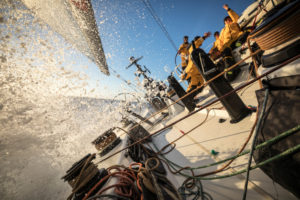
On the final afternoon we had great winds and clear skies with 20 knots of wind and 20 plus knots of boat speed. All three boats were in sight of each other as we sent it to Cape Town. We were lifted by the wind and all needed to gybe but someone had to break first. We didn’t want to be the last boat to gybe so we went for it and the other two came with us. Both of them were waiting and ready to go when they saw us gybe, as we would have been if our roles were reversed.
We all headed to Table Bay where we knew the wind would get funky. We lost two miles to Scally’s that afternoon due to poor positioning of the boat but we had pace and as we closed the bay we managed to reduce that deficit to two boat lengths.
Akzo Nobel got clear ahead at 4 miles out of Cape Town and so it was left to us and our shadow to finish this epic battle. Fickle winds and huge shifts meant we had a tough final four miles as we battled it out with Scally’s. We changed sails, we tacked several times, we were over powered, we were underpowered but ultimately victory was just out of our grasp. Only 1 minute and 8 seconds outside but close if no cigar.
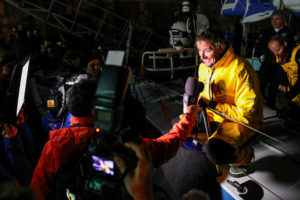
So, my ego has needed little soothing after yet another battle hard fought and not won by such a small margin but there are plenty of legs to come. I am sleeping, eating well and taking some time before we get back on our trusty steed to go again, only this time we are headed for the South and this time we have some serious scores to settle. In the last two legs we have matched raced with two different boats and lost out. Here’s hoping that third time is the charm!